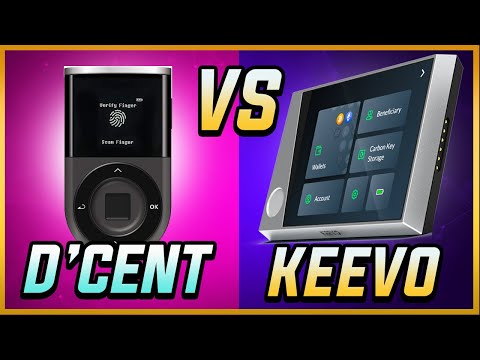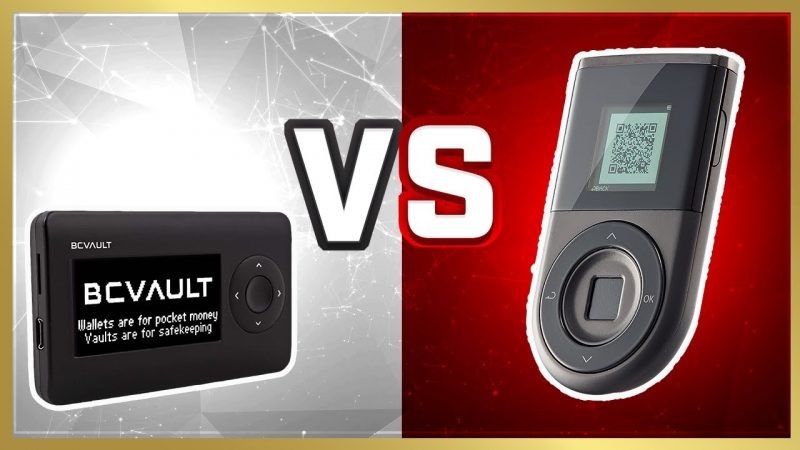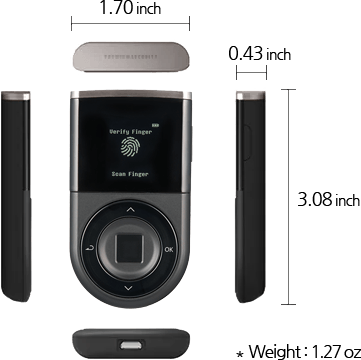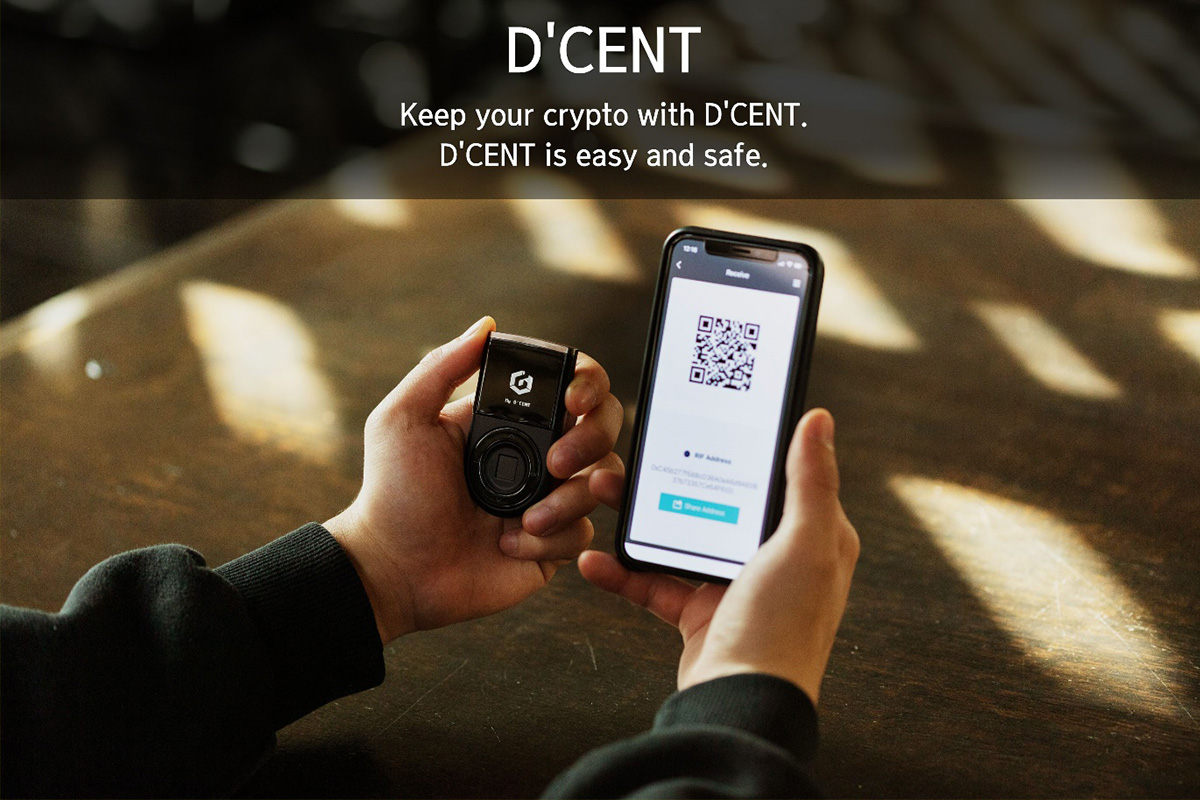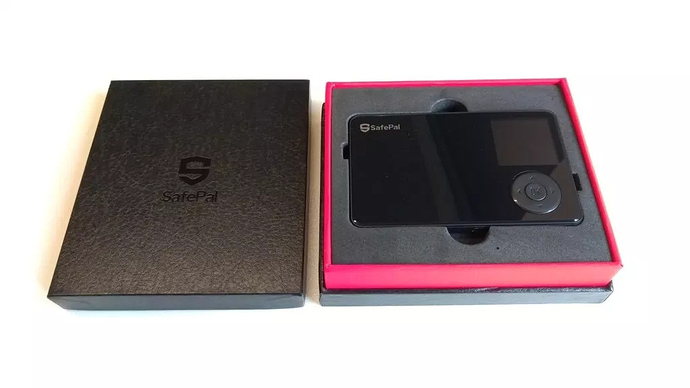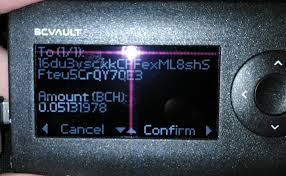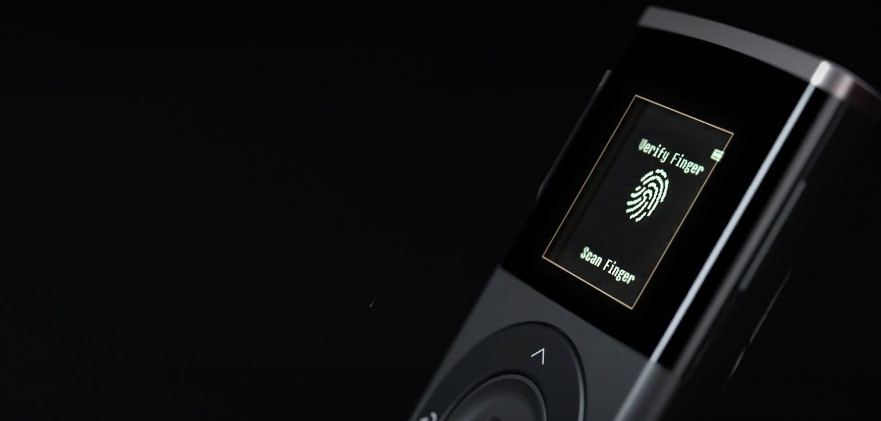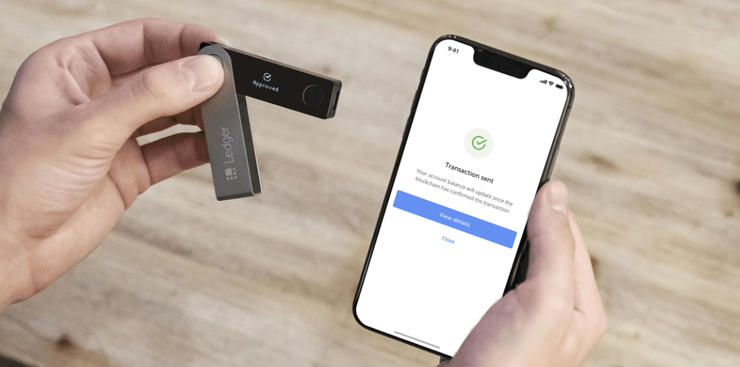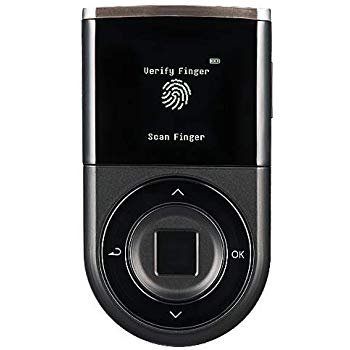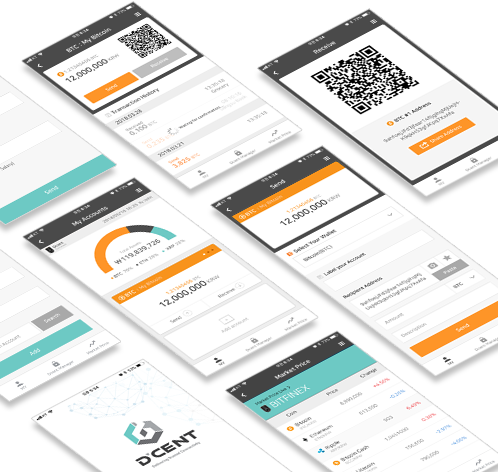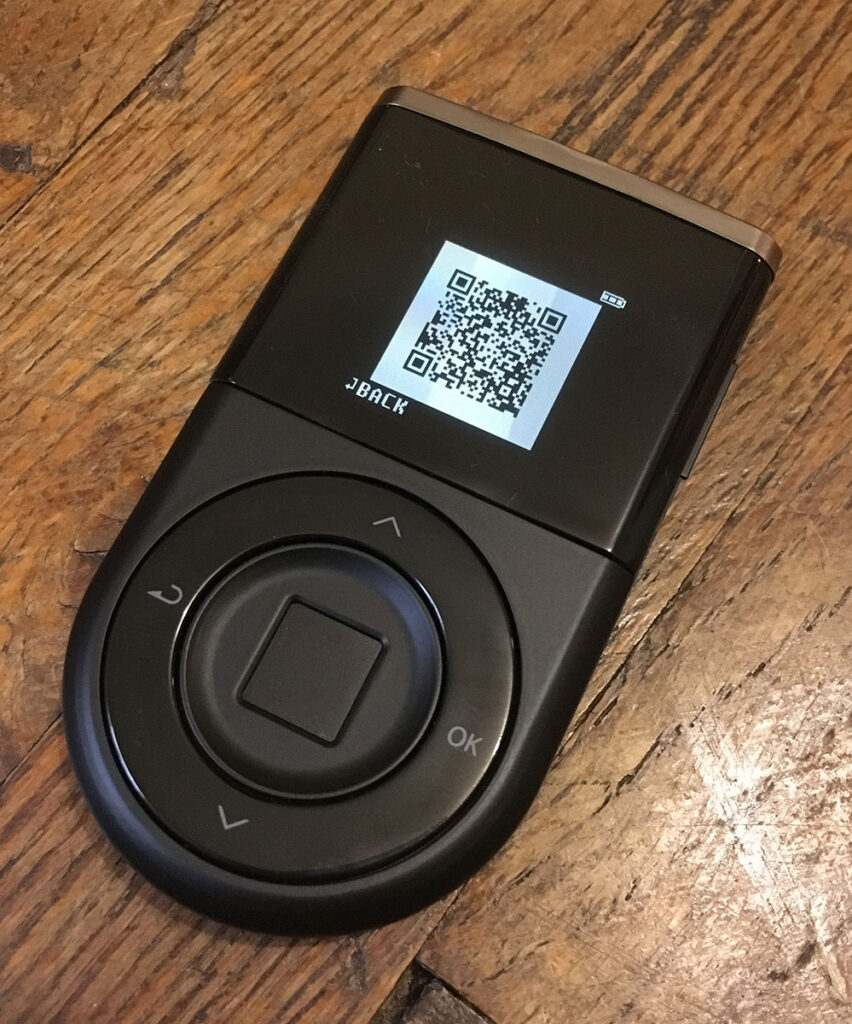- CRYPTO HARDWARE WALLETS
- NGRAVE ZERO
- COMPARE HARDWARE WALLETS
- KEEPKEY VS TREZOR VS LEDGER
- TREZOR VS TREZOR REVIEW
- KEEPKEY VS LEDGER NANO X
- LEDGER NANO X VS ELLIPAL TITAN
- LEDGER NANO X VS TREZOR MODEL T
- D’CENT VS LEDGER NANO X
- SAFEPAL VS LEDGER NANO S
- BC VAULT VS LEDGER NANO X
- BC VAULT VS D’CENT
- BC VAULT VS KEEPKEY
- SECUX V20 VS LEDGER NANO X
- D’CENT VS SAFEPAL
- SAFEPAL VS BC VAULT
- SAFEPAL VS KEEPKEY
- SAFEPAL VS ELLIPAL TITAN
- ELLIPAL TITAN VS KEEPKEY
- ELLIPAL TITAN VS BC VAULT
- ELLIPAL TITAN VS D’CENT
- KEEPKEY
- LEDGER NANO S
- LEDGER NANO X
- TREZOR ONE
- TREZOR MODEL T
- ELLIPAL TITAN
- ELLIPAL 2.0 (1st GEN)
- KEYSTONE PRO
- COOL WALLET S (WIRELESS)
- SAFEPAL S1
- D’CENT
- BC VAULT
- SECUX W10
- SECUX W20
- SECUX V20
- SECUX NIFTY
- KEEVO WALLET
- CYPHEROCK X1
- RECOVERY SEED BACKUPS
- PRODUCT REVIEWS
- VIDEOS
- RESOURCES
- CONTACT US
- Logo
- Facebook




- Instagram






- Twitter






- Youtube






- FREE E-BOOK






D’CENT Wallet
Ellipal Titan vs D’CENT (2020) | Which Wireless Hardware Wallet Is More Secure?
Ellipal Titan vs D’CENT! In this comparison, we are going to do a head-to-head of two of the most competitive and popular new cryptocurrency hardware wallets in this edition of the hardware wallet roundups.
I am going to dive into which of these hardware wallets is better and more secure. How big is your portfolio? Do you need mobile AND desktop support? Do you use any 3rd party wallets for integration? Do you need web-based access instead of a required download?
These are all questions you will need to consider when deciding which of these wallets will be best for you. At the end of the day, the coin support is one of the most important factors (besides security) when deciding which hardware wallet is best for you.
Ultimately, if it doesn’t support the coins you want to store offline, it won’t work for your particular situation. So keep that in mind as we dive into what I consider to be the most important factors when making such an important decision, such as choosing a cryptocurrency hardware wallet.
Ellipal Titan: Overview
This is a really unique device and has a very robust form factor that has ratings that rival that of some high-end smartphones. What separates this hardware wallet from the majority of other popular wallets is its communication method. So, what do I mean by that? This device has NO: USB Connection, NFC Connection, WiFi Connection, Bluetooth Connection, or Cellular Connection. So, how do you use it? The short answer is: QR Codes.
Ellipal Titan: Security
This is a 100% air-gapped device, so ultimately it is more secure than any other way to interact with a hardware wallet. Period. The device has a tamper-resistant enclosure that includes a self-destruct mechanism for any potential way to access the internals of the device.
It is built in such a way that if anyone tries to break the screen or drill a hole through the device in an attempt to open its internal layout, the private keys will be erased. This is extremely powerful and will ultimately deter people from trying to hack this completely wireless device.
Ellipal Titan: User Experience (UX)
This hardware wallet has a camera, a 4-inch full color display, and does not display any balances on the device itself. The portfolio management and execution of the device is managed via a companion iOS and Android app that is used to initiate transactions and allows you to utilize the camera from your smartphone to transfer funds securely to the cold wallet, and vice versa.
I have been using this device for several weeks now, and in my personal opinion, it has been super easy to use and also very secure. I like knowing that my device is essentially indestructible and does not require any other 3rd party connection in order for it to function. This not only makes it very convenient, but it also very secure and eliminates room for error when typing or copying pasting wallet addresses that you are trying to transact with.
Ellipal Titan: Coin Support
This is always the section I check the most when reviewing hardware wallets, because although functionality and security are important, none of that matters unless it supports the coins you want to store offline. So here is the current list of supported coins and the one that are currently in development listed in the above picture.
D’CENT: Overview
The D’CENT is a mobile and bluetooth connected wireless hardware wallet device. With additional biometric security and the ease of use, this is a contender for the easiest to use mobile and wireless wallet. So how is it different than Ledger Nano X or other bluetooth devices? The Biometric security is a large differentiator here. It’s super convenient and makes it easy to sign and authenticate transactions on the go.
This means if you want to move your crypto from cold storage to a hot wallet, it can be done quickly and easily. A common scenario here would be if you are trying to pay a friend or you’re shopping and want to pay for a product in store very seamlessly. Let’s take a look at the security, features, and price below to go into a little more detail.
D’CENT: Security
The flagship feature of D’CENT is hands down the biometric security feature of the fingerprint sensor. There are some other hardware wallets that communicate with mobile, and can utilize Face ID or Touch ID for extra authentication with their mobile app, but this gives your authentication on the physical device as well. This is a unique and very secure feature that is not used by any other hardware wallet currently on the market.
The hardware wallet features a built-in fingerprint scanner that manages access to the hardware wallet. This security process improves the convenience for the users and enhances the security during access control. It also provides the wallet with fast transaction signing.
- Multi-IC architecture design
- Bank grade EAL 5+ Secure Element (This is the same security chip used in the Ledger Nano X)
- Secure OS embedded on microprocessor
D’CENT: User Experience (UX)
One of the main features I like here is the option to generate a valid QR code on the large OLED screen of this device as a way to send funds directly from your smartphone to your D’CENT wallet. This is super convenient and truly makes this a wireless and independent device that can be used on the go via the D’CENT app, which also includes a market price section and of course all of your wallets and current fiat amount stored within each one.
What’s also nice is you no longer need to backup and restore this device for firmware upgrades like you do with other devices (although you can, since this device can also support bluetooth and USB connectivity if you choose). This makes this a very convenient choice when considering the ease of use and security when choosing how to secure your private keys.
D’CENT: Coin Support
The coin support is varied. The D’CENT can store and support: Bitcoin, Ethereum, ERC20 tokens, RSK, RRC20 (RSK tokens), Ripple (XRP), and MONACOIN. To many, this may not seem like it is very much, however, a majority of the major tokens are ERC-20 tokens and all can be supported natively on this device, which is good. I have not come across a hardware wallet yet that supports RSK and RRC20 tokens yet natively, so that definitely makes this an exclusive hardware wallet first for the D’CENT wallet!
Ellipal Titan vs D’CENT: Conclusion
Overall, these are two very unique wallets, even though they are both wireless. On the one hand, the D’CENT wallet is cheaper (with my current discount of $106) and has a biometric authentication via fingerprint sensor. This is extremely compelling.
On the other hand, the Ellipal Titan is completely air gapped and is transmitted through scanning QR codes on the device camera and allows for multi-factor authentication. Both are unique in my opinion and have different selling points.
At the end of the day, you need to ask yourself what coins you need to store offline, and if you prefer a large or smaller device. They are both secure in their own unique ways, but I would have to still go in favor of the ELLIPAL TITAN.
You can’t beat the air-gapped security, and the user experience is much better on a larger screen, which also makes it easier to navigate and use on a regular basis. Although, if there was an under screen fingerprint sensor on future hardware wallet, that was also air-gapped and transmitted through QR codes, that would be a home run.
What do you think? Would you choose the BC VAULT over the D’CENT Wallet? Let us know down below in the comments!
Cheers,
The Crypto Renegade
NOTE: This post may contain affiliate links. This adds no cost to you but it helps me focus on giving as much value as possible in every single post by being compensated for recommending products that help people succeed.
D’CENT vs SafePal (2020) | Which Wireless Hardware Wallet Is Better?
D’CENT vs SafePal! In this comparison, we are going to do a head-to-head of two of the most competitive and popular new cryptocurrency hardware wallets in this edition of the hardware wallet roundups.
I am going to dive into which of these bluetooth hardware wallets is better and more secure. How big is your portfolio? Do you need mobile AND desktop support? Do you use any 3rd party wallets for integration? Do you need web-based access instead of a required download?
These are all questions you will need to consider when deciding which of these wallets will be best for you. At the end of the day, the coin support is one of the most important factors (besides security) when deciding which hardware wallet is best for you.
Ultimately, if it doesn’t support the coins you want to store offline, it won’t work for your particular situation. So keep that in mind as we dive into what I consider to be the most important factors when making a such an important decision, such as choosing a cryptocurrency hardware wallet.
SafePal: Overview
This device was originally created by Binance Labs division and wanted to have a unique approach to a hardware wallet that was cheap enough for the average user, but also supported the Binance chain and added support for their internal projects. This really is a unique entry level hardware wallet, that greatly differs in terms of design, functionality, and overall user experience.
SafePal: Security
This can be considered one of the most attractive features of the device as it’s only $39.99 for this hardware wallet. Yes, you read that right. But why is it so cheap? Well, even though it looks like a very sleek and expensive device, its is made of plastic coating and a very small camera module that is used to transact at a very low resolution.l It’s obvious that they built this as cheaply as they could, while still remaining secure.
This is not necessarily a bad thing, but you also get what you pay for. One of the key features that sets this device apart from most other competing hardware wallets is the fact that there is NO:
- NFC
- BLUETOOTH
- USB
- CELLULAR
- EXTERNAL DEVICE CONNECTIONS
This gives it extra security, but it also makes it easier to use, as there are no extra devices necessary for this to operate, other than your smartphone. All you need right out of the box is a charger that supports USB-A to charge the device and a smartphone to download the Safepal App to setup and initialize the device.
SafePal: User Experience (UX)
This is the cheapest completely wireless hardware wallet on the market. It interacts only with your smartphone and the camera embedded into the device that allows you to transmit encrypted data via the QR code. This is truly a unique device.
This is a pretty solid introductory hardware wallet. It’s unique from it’s direct competitors and its simple and easy to use. As mentioned above, it has no connection weaknesses and cannot be hacked by any radio frequency or directly connected internet device. It’s truly a unique wireless hardware wallet that can be used on the go and is one of only a few hardware wallets that are “truly wireless” with no dependence on other devices. Oh, and did I mentioned it’s under $40?
SafePal: Coin Support
This is the one weak point of this product is the lack of coin support, as it only supports: Bitcoin, Ether (and ERC-20 Tokens), BNB, Litecoin, Dash, and Bitcoin Cash, DigiByte (DGB), NEO, and Zcash (ZEC) . However, they have mentioned that there is Ripple (XRP) and Tron (TRX) coming very shortly. They truly are attempting to add more coins, and over time, if they don’t raise their price, this option will be a slam dunk for most users.
Additionally, I will add that the Binance Chain Coins (BEP2) tokens are also supported as this is a Binance hardware wallet after all. Below Is a full list of coins currently supported.
D’CENT: Overview
The D’CENT is a mobile and bluetooth connected wireless hardware wallet device. With additional biometric security and the ease of use, this is a contender for the easiest to use mobile and wireless wallet. So how is it different than Ledger Nano X or other bluetooth devices? The Biometric security is a large differentiator here. It’s super convenient and makes it easy to sign and authenticate transactions on the go.
This means if you want to move your crypto from cold storage to a hot wallet, it can be done quickly and easily. A common scenario here would be if you are trying to pay a friend or you’re shopping and want to pay for a product in store very seamlessly. Let’s take a look at the security, features, and price below to go into a little more detail.
D’CENT: Security
The flagship feature of D’CENT is hands down the biometric security feature of the fingerprint sensor. There are some other hardware wallets that communicate with mobile, and can utilize Face ID or Touch ID for extra authentication with their mobile app, but this gives your authentication on the physical device as well. This is a unique and very secure feature that is not used by any other hardware wallet currently on the market.
The hardware wallet features a built-in fingerprint scanner that manages access to the hardware wallet. This security process improves the convenience for the users and enhances the security during access control. It also provides the wallet with fast transaction signing.
- Multi-IC architecture design
- Bank grade EAL 5+ Secure Element (This is the same security chip used in the Ledger Nano X)
- Secure OS embedded on microprocessor
D’CENT: User Experience (UX)
One of the main features I like here is the option to generate a valid QR code on the large OLED screen of this device as a way to send funds directly from your smartphone to your D’CENT wallet. This is super convenient and truly makes this a wireless and independent device that can be used on the go via the D’CENT app, which also includes a market price section and of course all of your wallets and current fiat amount stored within each one.
What’s also nice is you no longer need to backup and restore this device for firmware upgrades like you do with other devices (although you can, since this device can also support bluetooth and USB connectivity if you choose). This makes this a very convenient choice when considering the ease of use and security when choosing how to secure your private keys.
D’CENT: Coin Support
The coin support is varied. The D’CENT can store and support Bitcoin, Ethereum, ERC20 tokens, RSK, RRC20 (RSK tokens), Ripple (XRP), and MONACOIN. To many, this may not seem like it is very much, however, a majority of the major tokens are ERC-20 tokens and all can be supported natively on this device, which is good. I have not come across a hardware wallet yet that supports RSK and RRC20 tokens yet natively, so that definitely makes this an exclusive hardware wallet first for the D’CENT wallet!
D’CENT vs SafePal: Conclusion
Overall, these are two of the most interesting wallets out there. On the one hand, the SafePal is embracing the QR code level security of an entry level wallet, but is lacking in its overall coin support. I do expect this to change over time and expand their offerings as they begin to gain market share.
On the other hand, the D’CENT is the only hardware wallet that offers biometric securirty (by use of your thumbprint) as an extra layer of security for signing and authorizing transactions. This is nice in knowing that no one can process any transactions, even if they know your password and/or PIN code.
The D’CENT is also lacking (in comparison to other mainstream hardware wallets) in terms of coin support, but supports the RSK chain (Bitcoin Side-Chain) that is unique to this wallet and will still support all the main coins you get on every other hardware wallet.
At the end of the day, I would go with the SafePal. It’s currently under $40 and has air-gapped technology and is a completely wireless device that doesn’t require you to connect to a computer to manage your crypto assets. That’s not to say the D’CENT is bad, I just would rather spend less and get what some could construe as a better security model, even though its current coin support leaves much to be desired.
What do you think? Would you choose the D’CENT over the SafePal? Let us know down below in the comments!
Cheers,
The Crypto Renegade
NOTE: This post may contain affiliate links. This adds no cost to you but it helps me focus on giving as much value as possible in every single post by being compensated for recommending products that help people succeed.
BC VAULT vs D’CENT (2020) | Which New Hardware Wallet Is Better?
BC VAULT vs D’CENT! In this comparison, we are going to do a head-to-head of two of the most competitive and popular new cryptocurrency hardware wallets in this edition of the hardware wallet roundups.
I am going to dive into which of these hardware wallets is better and more secure. How big is your portfolio? Do you need mobile AND desktop support? Do you use any 3rd party wallets for integration? Do you need web-based access instead of a required download?
These are all questions you will need to consider when deciding which of these wallets will be best for you. At the end of the day, the coin support is one of the most important factors (besides security) when deciding which hardware wallet is best for you.
Ultimately, if it doesn’t support the coins you want to store offline, it won’t work for your particular situation. So keep that in mind as we dive into what I consider to be the most important factors when making such an important decision, such as choosing a cryptocurrency hardware wallet.
BC VAULT: Overview
Unlike most other popular cryptocurrency hardware wallets, like Ledger Nano X and Trezor Model T, you do not set up a recovery seed card before you initialize the device. In fact, there is a gyro sensor for you to randomly generate private keys by physically shaking the device (seriously).
You can also hold more than 2000 unique wallets within the web app, and can granularly set specific passwords for each one and setup multiple PIN’s to not only make it more secure, but also allows for an easy way to share the device and use Multi-Sig. In fact, this is the first device that natively allows you to use Multi-Sig on a per wallet basis and set multiple PIN’s.
This wallet does not use HD wallets, so each wallet has its own unique backup. This does make it more secure, however, if you lose or forget the global PIN and global password for the device, your funds are locked inside forever. They do have an encrypted QR code backup for each individual wallet, or you can create a backup on the included micro SD card that comes in the box.
BC VAULT: Security


The storage is reliable. The BC Vault’s private keys have complete encryption and they are stored in the FRAM device. The FRAM is fully tamper-resistant and thanks to the reversible USB 3.0 Type-C connector any damage occurring from mechanical error is fully prevented.
In addition to the secure FeRAM that is securely encrypted, and the large display which is useful when confirming transactions, you have peace of mind not having to worry about anyone locating or using a recovery seed phrase to render your funds useless.
You can also import any private keys you have elsewhere via the SD card as well, so you can easily interchange private keys from other wallets if you have them in the correct format.
BC VAULT: User Experience (UX)
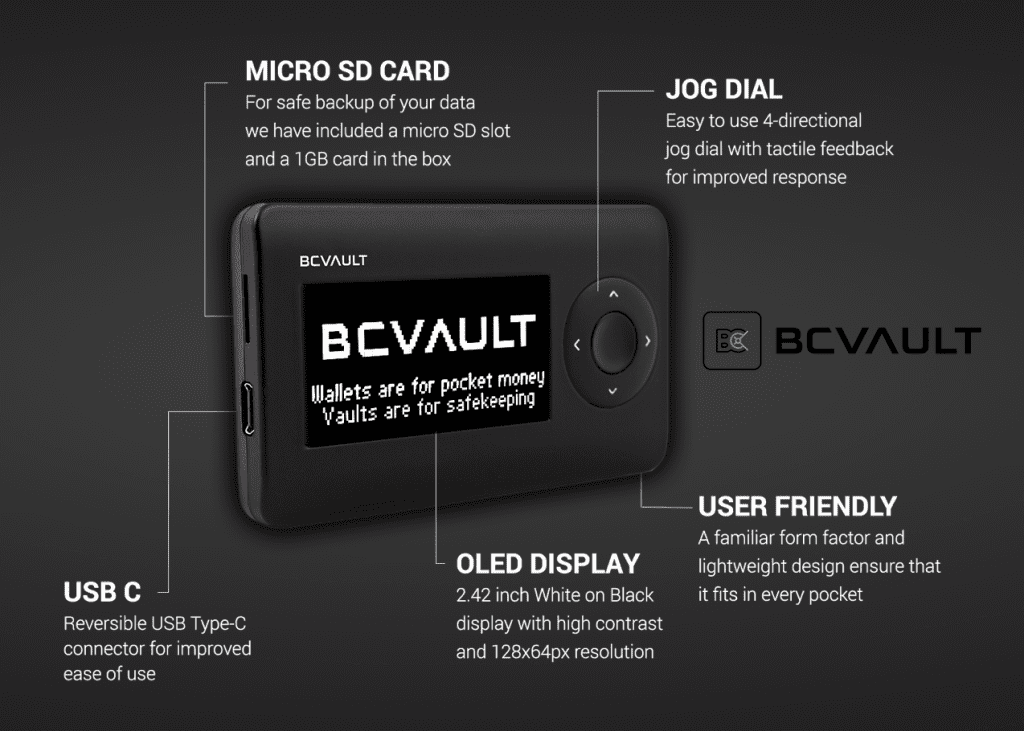

This wallet has some pretty unique features I will admit, and it’s pretty refreshing. For example, you can use multiple cryptocurrencies at once. There are no “apps” you need to install or fear or worry of running out of space that most wallets have when upgrading the firmware.
Additionally, the amount of coins and wallets that can be used/stored simultaneously is astounding. As mentioned above, you can have up to 2000 unique wallets and can interchange multiple cryptos in multiple wallets.
BC VAULT: Coin Support
This is usually one of the most important factors when deciding on a hardware wallet (with the exception of security). If the wallet doesn’t currently support the coins you need to store offline, you can’t really take it too seriously as a deciding factor for purchase. Regardless of whether or not they claim to add more coins in the future.
Needless to say, they have some unique choices for coin support HERE.
D’CENT: Overview
The D’CENT is a mobile and bluetooth connected wireless hardware wallet device. With additional biometric security and the ease of use, this is a contender for the easiest to use mobile and wireless wallet. So how is it different than Ledger Nano X or other bluetooth devices? The Biometric security is a large differentiator here. It’s super convenient and makes it easy to sign and authenticate transactions on the go.
This means if you want to move your crypto from cold storage to a hot wallet, it can be done quickly and easily. A common scenario here would be if you are trying to pay a friend or you’re shopping and want to pay for a product in store very seamlessly. Let’s take a look at the security, features, and price below to go into a little more detail.
D’CENT: Security
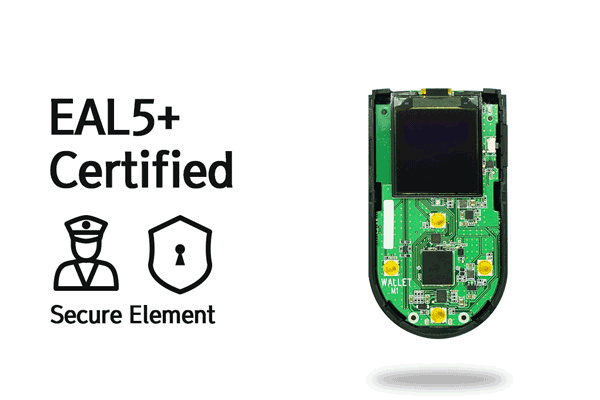

The flagship feature of D’CENT is hands down the biometric security feature of the fingerprint sensor. There are some other hardware wallets that communicate with mobile, and can utilize Face ID or Touch ID for extra authentication with their mobile app, but this gives your authentication on the physical device as well. This is a unique and very secure feature that is not used by any other hardware wallet currently on the market.
The hardware wallet features a built-in fingerprint scanner that manages access to the hardware wallet. This security process improves the convenience for the users and enhances the security during access control. It also provides the wallet with fast transaction signing.
- Multi-IC architecture design
- Bank grade EAL 5+ Secure Element (This is the same security chip used in the Ledger Nano X)
- Secure OS embedded on microprocessor
D’CENT: User Experience (UX)
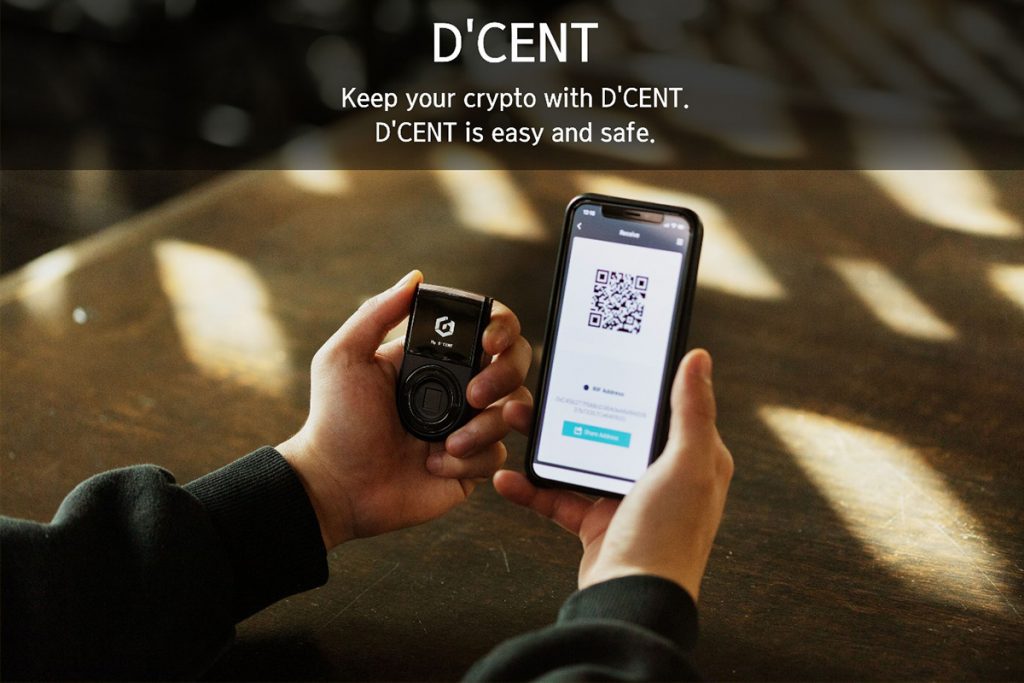

One of the main features I like here is the option to generate a valid QR code on the large OLED screen of this device as a way to send funds directly from your smartphone to your D’CENT wallet. This is super convenient and truly makes this a wireless and independent device that can be used on the go via the D’CENT app, which also includes a market price section and of course all of your wallets and current fiat amount stored within each one.
What’s also nice is you no longer need to backup and restore this device for firmware upgrades like you do with other devices (although you can, since this device can also support bluetooth and USB connectivity if you choose). This makes this a very convenient choice when considering the ease of use and security when choosing how to secure your private keys.
D’CENT: Coin Support
The coin support is varied. The D’CENT can store and support Bitcoin, Ethereum, ERC20 tokens, RSK, RRC20 (RSK tokens), Ripple (XRP), and MONACOIN. To many, this may not seem like it is very much, however, a majority of the major tokens are ERC-20 tokens and all can be supported natively on this device, which is good. I have not come across a hardware wallet yet that supports RSK and RRC20 tokens yet natively, so that definitely makes this an exclusive hardware wallet first for the D’CENT wallet!
BC VAULT vs D’CENT: Conclusion
Overall, these are two of the most unique wallets I’ve ever used. The biometric fingerprint sensor that the D’CENT has, with the flexibility of bluetooth feature for both mobile and desktop support is a nice selling point. The coin support is not that robust (yet), but I believe in time it will be competing amongst the best.
Not to mention, with my discount offered below via my partnership with them, you can get this wallet for only $106, which does make it cheaper than the BC Vault.
With that said, the BC VAULT has a very clean UI and user experience, and uniquely supports over 2000 different wallets and allows for very easy-to-use multiple signatures is a VERY secure feature you don’t see easily used on most other hardware wallets.
If I had a gun to my head and had to pick which one of these wallets I had to pick, I would go with the BC VAULT, it’s far more unique and having multi-sig is a very useful and secure feature, although I really do like the biometric authentication with the D’CENT. BC VAULT wins this round.
What do you think? Would you choose the BC VAULT over the D’CENT Wallet? Let us know down below in the comments!
Cheers,
The Crypto Renegade
NOTE: This post may contain affiliate links. This adds no cost to you but it helps me focus on giving as much value as possible in every single post by being compensated for recommending products that help people succeed.
D’CENT vs Ledger Nano X (2020) | Which Bluetooth Hardware Wallet Is Safer?
D’CENT vs Ledger Nano X! In this comparison, we are going to do a head-to-head of two of the most competitive and popular new cryptocurrency hardware wallets in this edition of the hardware wallet roundups.
I am going to dive into which of these bluetooth hardware wallets is better and more secure. How big is your portfolio? Do you need mobile AND desktop support? Do you use any 3rd party wallets for integration? Do you need web-based access instead of a required download?
These are all questions you will need to consider when deciding which of these wallets will be best for you. At the end of the day, the coin support is one of the most important factors (besides security) when deciding which hardware wallet is best for you.
Ultimately, if it doesn’t support the coins you want to store offline, it won’t work for your particular situation. So keep that in mind as we dive into what I consider to be the most important factors when making such an important decision, such as choosing a cryptocurrency hardware wallet.
Ledger Nano X: Overview
The Nano X comes beautifully packaged with the device itself, a USB-C cable, a set of instructions and recovery seed cards. The previous bulky buttons that were on top of the device are now seamlessly integrated on it in a way that’s even a bit hard to notice. All in all a beautiful design. The primary features of this device are the bluetooth connection which allows you to manage this device using your smartphone via the iOS and Android app.
Additionally, you can now hodl, store, or manage up to 100 cryptos simultaneously, all without access to your desktop or laptop computer. This is easily it’s best new features, but aside from the upgraded storage capacity and the wireless connectivity, the device itself is now larger, has an integrated 2-function button, and an overall larger screen for verifying transactions. With a trusted device and a more universal charging cable, this makes it much more compelling to spend the extra money to store more coins and one that you can easily take with you as you travel.
Ledger Nano X: Security
Ledger is at the forefront of developing the industry’s device security. How? And in what ways?
CC EAL5+ SECURE ELEMENT
Only Ledger’s devices can claim the French cybersecurity agency ANSSI’s full certification.
The Nano X and Nano S both feature what is called a ‘secure element’. The chip seen below is the next generation chip that comes in the Nano X:
The secure chip meets the CC EAL5+ certification and run’s Ledger’s proprietary BOLOS operating system.
A Secure Element is a secure chip that…embeds intrinsic countermeasures against many known attacks. This kind of chip is tamper-resistant and protects your device to a range of different attacks.”
Ledger Nano X: Coin Support
The Ledger Nano X utilizes the “Ledger Live” dashboard which is a desktop application that allows you to manage all of your coins, portfolio, and potential trades in an easy to use application. You can use this on both an iOS or Android app as well as a desktop.
This app allows you to manage up to 1,100 coins that are supported by the device. However, only about 200 of them are “native” apps. This means that you can manage them directly within the Ledger Live app, without having to connect to a 3rd party wallet, such as MyEtherWallet or MyCrypto. I will leave a link HERE with a list of fully supported coins.
Ledger Nano X: User Experience
Honestly, the user experience is a massive upgrade from the Ledger Nano S. With that said, It has a few usability issues that I find to be quite difficult to overcome. Although this device is physically larger than its predecessor, it still has a fairly difficult to use early experience.
For example, the screen is still fairly small and still cannot accommodate a QR code for scanning. This may not seem like a big deal, but after using several hardware wallets, it really does make a big difference. Using a QR code is not only safer (because it removes the chance of error from manually typing in a wallet address), but it is incredibly faster and makes the entire of transacting offline, a much easier experience.
Although this device has stepped up the quality considerably from it’s latest iteration, I still feel that utilizing an all new form factor could have been beneficial and a little more innovative than replicating their 1st generation device with a few small tweaks.
D’CENT Wallet: Overview
The D’CENT is a mobile and bluetooth connected wireless hardware wallet device. With additional biometric security and the ease of use, this is a contender for the easiest to use mobile and wireless wallet. So how is it different than Ledger Nano X or other bluetooth devices? The Biometric security is a large differentiator here. It’s super convenient and makes it easy to sign and authenticate transactions on the go.
This means if you want to move your crypto from cold storage to a hot wallet, it can be done quickly and easily. A common scenario here would be if you are trying to pay a friend or you’re shopping and want to pay for a product in store very seamlessly. Let’s take a look at the security, features, and price below to go into a little more detail.
D’CENT: Security
The flagship feature of D’CENT is hands down the biometric security feature of the fingerprint sensor. There are some other hardware wallets that communicate with mobile, and can utilize Face ID or Touch ID for extra authentication with their mobile app, but this gives your authentication on the physical device as well. This is a unique and very secure feature that is not used by any other hardware wallet currently on the market.
The hardware wallet features a built-in fingerprint scanner that manages access to the hardware wallet. This security process improves the convenience for the users and enhances the security during access control. It also provides the wallet with fast transaction signing.
- Multi-IC architecture design
- Bank grade EAL 5+ Secure Element (This is the same security chip used in the Ledger Nano X)
- Secure OS embedded on microprocessor
D’CENT: Coin Support
The coin support is varied. The D’CENT can store and support Bitcoin, Ethereum, ERC20 tokens, RSK, RRC20 (RSK tokens), Ripple (XRP), and MONACOIN. To many, this may not seem like it is very much, however, a majority of the major tokens are ERC-20 tokens and all can be supported natively on this device, which is good. I have not come across a hardware wallet yet that supports RSK and RRC20 tokens yet natively, so that definitely makes this an exclusive hardware wallet first for the D’CENT wallet!
D’CENT: User Experience
One of the main features I like here is the option to generate a valid QR code on the large OLED screen of this device as a way to send funds directly from your smartphone to your D’CENT wallet. This is super convenient and truly makes this a wireless and independent device that can be used on the go via the D’CENT app, which also includes a market price section and of course all of your wallets and current fiat amount stored within each one.
What’s also nice is you no longer need to backup and restore this device for firmware upgrades like you do with other devices (although you can, since this device can also support bluetooth and USB connectivity if you choose). This makes this a very convenient choice when considering the ease of use and security when choosing how to secure your private keys.
D’CENT vs Ledger Nano X: Conclusion
Truth be told, these hardware wallets each have their own unique selling points (as you’ve seen above). It really depends on your situation. For example, if I only wanted to “HODL” the main market cap coins and wasn’t looking to build an expansive portfolio, I would choose the D’CENT wallet.
Why? Because the user experience in form factor is better (in my opinion) for ease of use, and overall security and the fingerprint authenticator gives me peace of mind. The Ledger Nano X is a solid device with a great track record and a trusted development team behind them. However, the screen size is not much bigger than their 1st generation device, and the form factor and user experience is much the same.
Overall, if I had to choose between these devices, it would really depend on which coins and the number of coins I needed to hold securely offline. They are both very high quality and fun devices in their own unique way. Having a bluetooth and wireless hardware wallet is really convenient and provides users a way to start using their hardware wallets in real-world scenarios. However, having that extra biometric security is really a game changer.
What do you think? Would you choose the KeepKey over the Ledger Nano X? Let us know down below in the comments!
Cheers,
The Crypto Renegade
NOTE: This post may contain affiliate links. This adds no cost to you but it helps me focus on giving as much value as possible in every single post by being compensated for recommending products that help people succeed.
D’CENT Wallet Review (2020) | The ONLY Biometric Crypto Hardware Wallet
In this review, we are going to deep-dive into the new hardware wallet by D’CENT! Does the D’CENT Wallet have a better user experience than the Ledger Nano X? Does It work with Bluetooth? How secure is this relatively new wallet? Does it provide a better hardware wallet experience than the main competitors? We are going to answer all of these questions and more in this in-depth review, so stay tuned!
If you are new to cryptocurrency hardware wallets and you want to compare which wallet is going to be best for you, you may want to check out the “Product Reviews” tab HERE.
But, since you are here for the D’CENT wallet review, let’s take a look at these details on the first biometric hardware wallet on the market. Let’s go!
D’CENT Wallet – Overview
The D’CENT is a mobile and bluetooth connected wireless hardware wallet device. With additional biometric security and the ease of use, this is a contender for the easiest to use mobile and wireless wallet. So how is it different than Ledger Nano X or other bluetooth devices? The Biometric security is a large differentiator here. It’s super convenient and makes it easy to sign and authenticate transactions on the go.
This means if you want to move your crypto from cold storage to a hot wallet, it can be done quickly and easily. A common scenario here would be if you are trying to pay a friend or you’re shopping and want to pay for a product in store very seamlessly. Let’s take a look at the security, features, and price below to go into a little more detail.
Features & Price
One of the main features I like here is the option to generate a valid QR code on the large OLED screen of this device as a way to send funds directly from your smartphone to your D’CENT wallet. This is super convenient and truly makes this a wireless and independent device that can be used on the go via the D’CENT app, which also includes a market price section and of course all of your wallets and current fiat amount stored within each one.
The PRICE is the nice part. Normally, this device is $159 USD, but for my readers, I am able to offer a special discount down to $140 (UPDATE: Until 11/28/19, You can get this device for only $106), when using code “bitcoinlockup” at checkout. This will ensure you will save some money in the process and will be more in line with the prices of other top-tier bluetooth hardware wallets.
What’s also nice, is you no longer need to backup and restore this device for firmware upgrades like you do with other devices (although you can, since this device can also support bluetooth and USB connectivity if you choose). This makes this a very convenient choice when considering the ease of use and security when choosing how to secure your private keys.
Security
The flagship feature of D’CENT is hands down the biometric security feature of the fingerprint sensor. There are some other hardware wallets that communicate with mobile, and can utilize Face ID or Touch ID for extra authentication with their mobile app, but this gives your authentication on the physical device as well. This is a unique and very secure feature that is not used by any other hardware wallet currently on the market.
The hardware wallet features a built-in fingerprint scanner that manages access to the hardware wallet. This security process improves the convenience for the users and enhances the security during access control. It also provides the wallet with fast transaction signing.
- Multi-IC architecture design
- Bank grade EAL 5+ Secure Element (This is the same security chip used in the Ledger Nano X)
- Secure OS embedded on microprocessor
Additionally, you have multiple authentication methods, with the option to have a PIN and/or fingerprint sensor to authorize changes and sign transaction, so you will 2-step authentication built in.
Coins Supported
The coin support is varied. The D’CENT can store and support Bitcoin, Ethereum, ERC20 tokens, RSK, RRC20 (RSK tokens), Ripple (XRP), and MONACOIN. To many, this may not seem like it is very much, however, a majority of the major tokens are ERC-20 tokens and all can be supported natively on this device, which is good. I have not come across a hardware wallet yet that supports RSK and RRC20 tokens yet natively, so that definitely makes this an exclusive hardware wallet first for the D’CENT wallet!
D’CENT Wallet – Conclusion
Overall, the D’CENT has some unique coin support choices, has a quality look and feel in your hands (even though it’s made of plastic), and kind of resembles a key fob for a very high end car. It feels very nice in the hand. As mentioned above, this is the first biometric hardware wallet with a fingerprint sensor built in to the device. It supports enough coins for the average user and it always plans to add more.
This device really feels like the first flexible wireless hardware wallet that is easy to use in a quick scenario on the go and doesn’t require additional steps to update the device and access all of its features. If you are looking for something that feels good in your hand, is super secure, and is easy to use, then this might be your best option for a premium hardware wallet.
What do you think? Would you rather have use the Ledger Nano X or try this new contender for wireless security? Let us know in the comments below!
Cheers,
The Crypto Renegade
NOTE: This post may contain affiliate links. This adds no cost to you but it helps me focus on giving as much value as possible in every single post by being compensated for recommending products that help people succeed.

